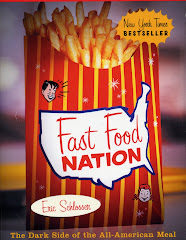1. How does the nutritional value of a McNugget compare with that of a hamburger?
- McNuggets, now made with "100% percent white meat", are now a integral part of the American
diet. McDonald's may advertise them as the healthiest part of the menu, but in reality, they are just
as disastrously unhealthy as the rest of the choices. Researchers found that their "fatty acid
profile" resembled beef, rather than poultry. They contain two times as much fat per ounce than
the regular McDonald's hamburger. They now incorporate beef tallow into their vegetable oil to
retain that familiar taste that America's youth knows and loves.
2. How does the suicide rate for ranchers and farmers compare with the rate for U.S. citizens in general?
- The rate of suicide for farmers and ranchers is about three times higher than that of regular U.S. citizens. Ranchers' ways of life have been destroyed with the homogenization of the cattle, pork, and poultry market, and therefore, the death toll has been steadily mounting in rural areas. This issue, like many of the problems resulting from fast food, has been almost completely ignored since the farm crisis of 1980.
3. What are "captive supplies" of cattle?
- Captive supplies are products that are supplies (surprisingly) not actually owned by a company but used by companies at the expense of those who actually own the supplies. Usually, the market for captive supplies, such as cattle, are controlled by several large corporations. In the case of cattle, ConAgra, IBP, Excel, and National Beef. These companies usually illegally collude and dominate the market together, as shown by the case of the Beef Trust of the early 1900s. Now, laws have been passed to make sure that the beef market is not monopolized like it was before, but this hardly stopping the companies. Cattle are owned by independent ranchers, who get paid by companies to raise them and prepare them for the slaughterhouse. Since beef consumption has declined in recent years, farmers have taken the advice of agribusinesses and given their cattle growth hormones. According to some ranchers, captive supplies of cattle are used to control the cattle market, and not improve slaughterhouse efficiency, as stated by the four major beef companies.
